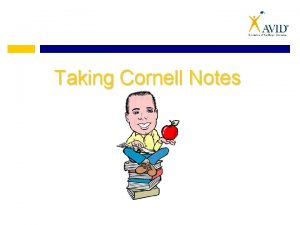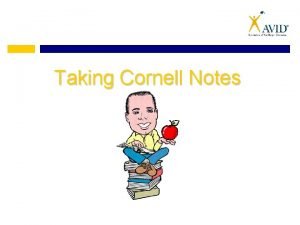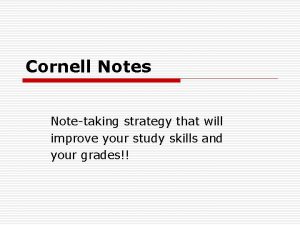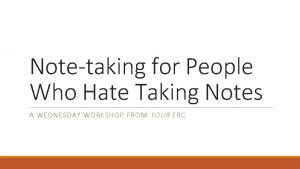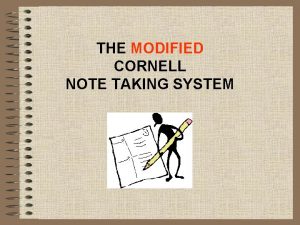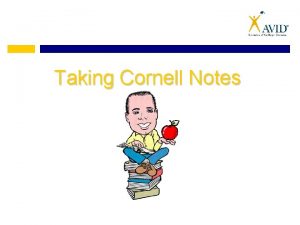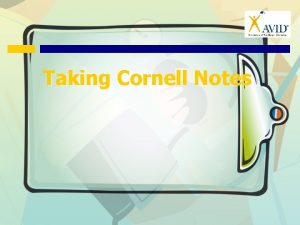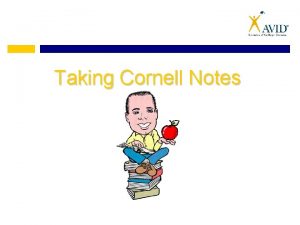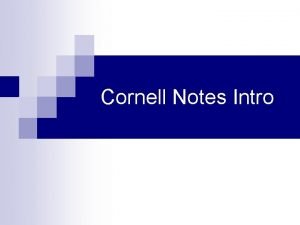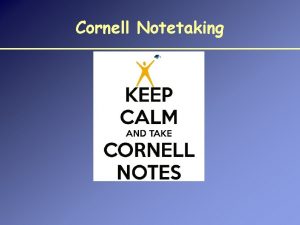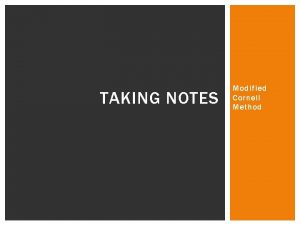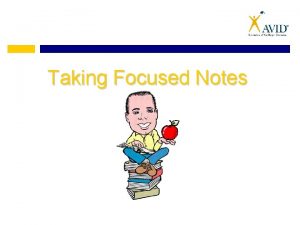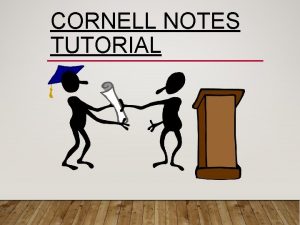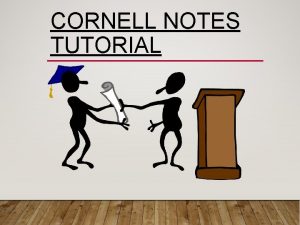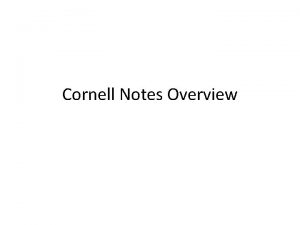Taking Cornell Notes What do Cornell Notes Look















- Slides: 15

Taking Cornell Notes

What do Cornell Notes Look Like? Essential Question Heading Main Ideas Notes Summary

S. T. A. R. • Set up your paper • Take the notes • Apply your thinking to the notes (Main Idea) • Reflect & Review your notes.

Set Up Your Paper Ch. 1, Lesson 1 EQ: What is history important ? Main Ideas go here You write notes here 1. Put a proper heading in the top right corner. 2. Write the chapter #, lesson #, and essential question. 3. Use three fingers on the left hand side of paper for main ideas by folding your paper.

Take Notes Ch. 1, Lesson 1 EQ: What is history important ? History studies people and events of the past. • Explores the ways that cultures change over time 1. Write notes on the right side of the pg. (bullets) • Big Ideas • Important Details • Key vocabulary

Apply Your Thinking What is History? What is History studies people History? and events of the past. • Explores the ways that cultures change over time • AFTER writing notes, review your notes and write the Main Idea on the left side of the page. * • Turn book headings into questions * Do this AFTER you write notes.

Reflect on Notes What is history important ? What is History studies History? people and events of the past • Explores the ways that cultures change over time Summary History studies people and events. The people who study history are called historians. They study how cultures have changed over time. • Add a summary to your notes (3 -5 sentences) 1. What did I learn? 2. Answer the essential question

Review Notes • Fold your notes so that the questions show, but the notes do not. • Quiz yourself or work with another student to quiz each other.

The Value of Cornell Notes • Students who don't take notes retain less than 59% of what was learned. • Students who take and use Cornell Notes as a study tool retain 90%-100% of what was learned.

Activity: Time to Practice • Turn to pg. 4 • Begin writing Cornell Notes on pg. 4 and pg. 5. This should take you 20 minutes.

Front of your Paper

Back of Your Paper

THINK: When should you take notes? Think about when you should take notes in class. • Make a list. • Be prepared to share with the class!

When to Take Notes • The speaker says to take notes • The speaker says something you don’t already know • The speaker presents using Powerpoint • The speaker writes on the board • When you read on your own.

The Curve of Forgetting • By day 2, if you do not think about or review your notes, you will lose 50%-80% of what you learned. • By day 30, if you do not think about or review your notes, you remember only 2% - 3% of what you learned on day 1. Source: Counseling Services, Study Skills Program at the University of Waterloo
 Look to the right look to the left
Look to the right look to the left What do cornell notes look like
What do cornell notes look like What does cornell notes look like
What does cornell notes look like Cornell note taking strategy
Cornell note taking strategy Cornell note taking strategy
Cornell note taking strategy Note taking 101
Note taking 101 Minion note it
Minion note it I hate taking notes
I hate taking notes Activity 4 look at the pictures
Activity 4 look at the pictures Go back and look at your answer for activity 1
Go back and look at your answer for activity 1 Activity 1 look at the picture
Activity 1 look at the picture Walter pauk cornell notes
Walter pauk cornell notes Modified cornell notes
Modified cornell notes Cornell notes rubric
Cornell notes rubric Cornell notes for anatomy and physiology
Cornell notes for anatomy and physiology Cornell notes advantages
Cornell notes advantages

